Cascade Field, Part of Año Nuevo State Park, May 2014
By Toni Corelli, Chapter Chair Rare Plants, San Mateo County
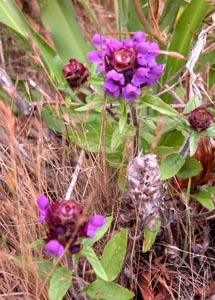
Cascade field is the best example of native coastal terrace prairie and associated wildflowers along the San Mateo Coast. Eight people joined California Native Plant Society member Toni Corelli (This email address is being protected from spambots. You need JavaScript enabled to view it.) and State Park volunteer Avis Boutell on the May 6, 2014 walk along the Atkinson Bluff Trail at Cascade Field.
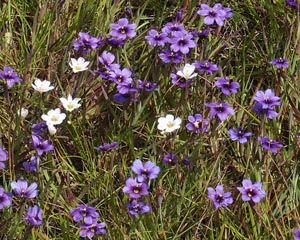
In the past the prairie was managed through fire by the Native Americans to bring grazing animals into the area and enhance desired plants that produce seeds that were gathered for food. Coastal prairies require some sort of disturbance regime to sustain them--either by grazing or fire--or bushes will grow and the prairie will turn into coastal scrubland.
Read more ...
Sharsmith Herbarium 2013
By Carol Mattsson, Chapter Newsletter Editor
On September 15, 2013 I joined several other Chapter members in a field trip to visit Sharsmith Herbarium at San Jose State University. The trip was led by Curator Toni Corelli and Assistant Curators Teri Barry and Lars Rosengreen.
The herbarium is named for botanist Carl Sharsmith, who started the herbarium and collected and mounted over 15,000 specimens. We started our tour in the room with the many rows of cabinets holding the herbarium sheets.
SPECIMEN SHEETS
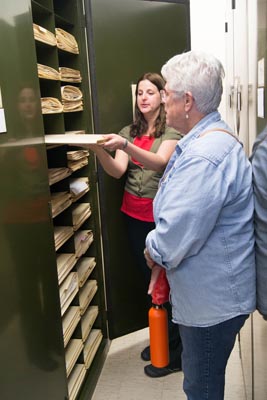 The curators had taken out several specimen sheets for us to examine
The curators had taken out several specimen sheets for us to examine 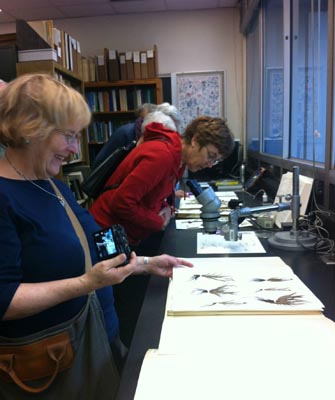 . We learned that the most damage to the specimens is from insects. Thus the first step for a dried, pressed plant specimen to become part of the herbarium collection is to freeze it for a week at -20 degrees F. When we examine the specimen we are to keep the sheet specimen-side up, and not roll or bend it in any way. After we examine the specimen we put the sheet in a special case designated for a refreeze before being restored to its permanent cabinet.
. We learned that the most damage to the specimens is from insects. Thus the first step for a dried, pressed plant specimen to become part of the herbarium collection is to freeze it for a week at -20 degrees F. When we examine the specimen we are to keep the sheet specimen-side up, and not roll or bend it in any way. After we examine the specimen we put the sheet in a special case designated for a refreeze before being restored to its permanent cabinet.
I like ferns so I enjoyed a good look at a specimen of Dryopteris arguta. 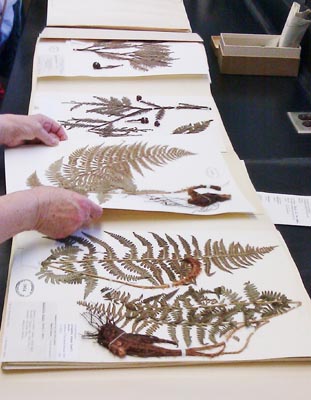 This specimen had the roots tied to the page with special linen thread, and in other places the specimen was attached to the page with special linen strips. As you can see in the photo, each herbarium sheet has a unique identifying number, called the "accession number." The sheets contain labels identifying the specimen: The lower right is the original label, showing plant name, date collected and by whom, location found, and other information. A second newer, smaller label is being added to all the specimens now, giving the plant's name in the 1993 version of the Jepson Manual.
This specimen had the roots tied to the page with special linen thread, and in other places the specimen was attached to the page with special linen strips. As you can see in the photo, each herbarium sheet has a unique identifying number, called the "accession number." The sheets contain labels identifying the specimen: The lower right is the original label, showing plant name, date collected and by whom, location found, and other information. A second newer, smaller label is being added to all the specimens now, giving the plant's name in the 1993 version of the Jepson Manual.
Read more ...


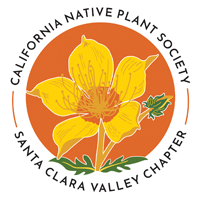

 The curators had taken out several specimen sheets for us to examine
The curators had taken out several specimen sheets for us to examine  . We learned that the most damage to the specimens is from insects. Thus the first step for a dried, pressed plant specimen to become part of the herbarium collection is to freeze it for a week at -20 degrees F. When we examine the specimen we are to keep the sheet specimen-side up, and not roll or bend it in any way. After we examine the specimen we put the sheet in a special case designated for a refreeze before being restored to its permanent cabinet.
. We learned that the most damage to the specimens is from insects. Thus the first step for a dried, pressed plant specimen to become part of the herbarium collection is to freeze it for a week at -20 degrees F. When we examine the specimen we are to keep the sheet specimen-side up, and not roll or bend it in any way. After we examine the specimen we put the sheet in a special case designated for a refreeze before being restored to its permanent cabinet. This specimen had the roots tied to the page with special linen thread, and in other places the specimen was attached to the page with special linen strips. As you can see in the photo, each herbarium sheet has a unique identifying number, called the "accession number." The sheets contain labels identifying the specimen: The lower right is the original label, showing plant name, date collected and by whom, location found, and other information. A second newer, smaller label is being added to all the specimens now, giving the plant's name in the 1993 version of the Jepson Manual.
This specimen had the roots tied to the page with special linen thread, and in other places the specimen was attached to the page with special linen strips. As you can see in the photo, each herbarium sheet has a unique identifying number, called the "accession number." The sheets contain labels identifying the specimen: The lower right is the original label, showing plant name, date collected and by whom, location found, and other information. A second newer, smaller label is being added to all the specimens now, giving the plant's name in the 1993 version of the Jepson Manual.